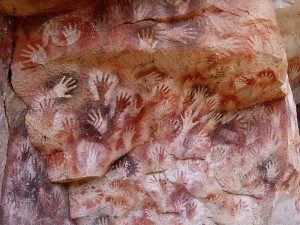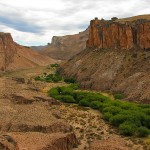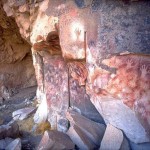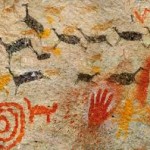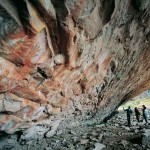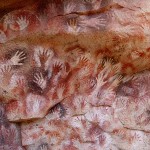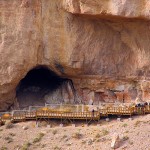Hands Cave is an archaeological site and cave paintings found in the deep canyon of Pinturas River in Buenos Aires el Departamento Lake west of Santa Cruz province in Argentina .
His interest lies in the beauty of the paintings , as well as its great antiquity : so far, the oldest inscriptions are dated 9300 years adP (‘ before present ‘, officially : 1950 ) , equivalent to the year 7350 to . C. It is one of the oldest towns of South American artistic expression and has been declared a World Heritage Site by Unesco .
The Cave of the Hands belongs to a series of American archeological sites such as Monte Verde ( Chile) , Pedra Furada ( Brazil ) , and Stone Museum ( Argentina ), among others who are questioning the traditional theory of the delayed settlement of America , to hold a theory of early settlement .
Other nearby settlement was located in Los Toldos , also in the Province of Santa Cruz, with remains dating adP 12 500 ( 10 500 a. C. ) .
The main cave is carved by erosion in the high walls that accompany the Paints river valley high in the northwest of the province of Santa Cruz, and south of the town of Perito Moreno. The cave has several eaves, and has inside cave paintings made over an extended period from 9300 to 1300. They are the first known art forms of the South American peoples .
In such paintings that reproduce figures related to the daily life of the Indians and their predecessors tehuelches , former hunter gatherers elements are observed. Of these the most famous and oldest are the silhouettes in positive and negative hands ( 829 were counted ) , in some cases overlapping . These silhouettes were made by ancient methods of airbrushing ( chromatic material is applied as a spray blown through the hollow core of small animal bones ) .
Also, you can see silhouettes of animals ( mainly guanacos and rheas ) major components of the diet of ancient peoples , they often scenes of collective hunting of these animals are shown.
As for the representation of the human figure , it is also a lesser frequency and linear forms .
Most common are geometric (mostly spirals) that would symbolically representing the unknown deities today .
The range of colors is dominant which means red , ocher, yellow, white and black . They are confeccionaba with fruit, nuts and crushed rocks. Also , by contagious magic ( as ranked by Fraser) – blood of animals hunted and the fat thereof was used as a binder .
The subjects respond to three different periods ; the oldest and least – abstract- is rich in hunting scenes ; excel in interim hands found secondarily accompanied by the representation of individual animals ; in the last period the predominant theme is that of geometric patterns , lines, dots and mandalas meaning of which is unknown.
These works of art were discovered to Western culture in 1876 by the Argentine explorer Francisco Moreno .
The meaning of such representations is currently hypothetical , although almost certainly be part of a ritual with high magic component , there are also impressions positive hands (ie , achieved by supporting the walls of the palms stained with paint ) .
At present, due to irresponsible tourism and the lack of a legal framework , most of the caves of the country is in danger. La Cueva de las Manos is one of them. The natural environment of a cave ‘s main features dark , temperature, and humidity levels stable. This environment – which houses wildlife, lakes , tunnels , ancient mineral deposits , archaeological and saved precious earth – is threatened by excessive tourist visits . According to statements of Vice FADE ( Argentina Federation of Speleology ) , ‘without a previous study and a management plan in a cave, the human presence steadily causes alterations in the middle with an impact, sometimes irreversible. Along with this said , the goal of sustainable development is that resource use is sustainable over time and that future generations have the same benefit of visiting the same cave.
The Cave of the Hands , a World Heritage Site by UNESCO in 1999 , has been painted , deeds and broken walls. The president of the FADE ‘ caves contain unique information for the reconstruction of paleoclimates : from the study of stalactites and stalagmites can be reconstructed climates area of 50 000 years. That wins speleothem breakage and hugs by tourists to take a photo or take souvenirs . Surely they do not know the damage they do , as a stalactite takes more than a thousand years to grow only 1 centimeter »

